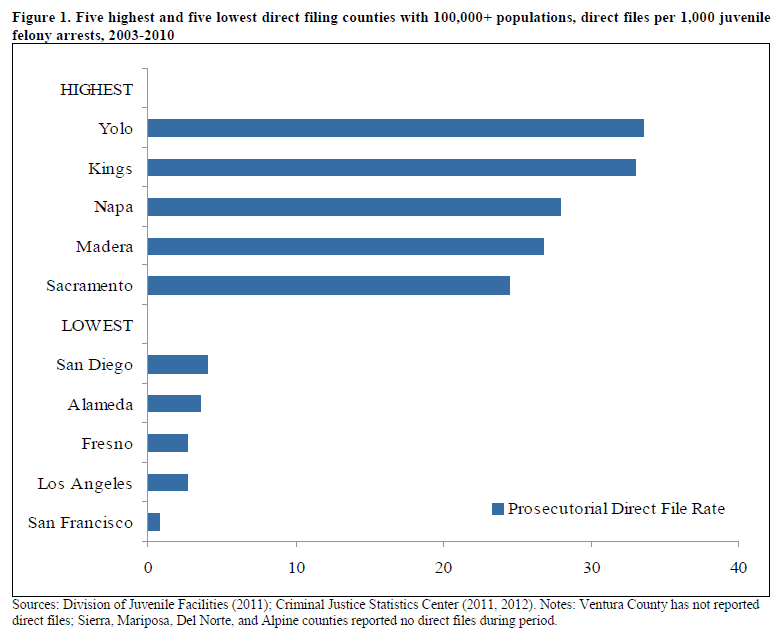 When five defendants – four of them juveniles under the age of 16 were arrested in January of 2011 for assault and robbery, the Yolo County District Attorney’s office refused to drop the gang charges. Because the gang charges remained in place, the DA’s office was able to continue their direct filing of the juveniles.
When five defendants – four of them juveniles under the age of 16 were arrested in January of 2011 for assault and robbery, the Yolo County District Attorney’s office refused to drop the gang charges. Because the gang charges remained in place, the DA’s office was able to continue their direct filing of the juveniles.
Direct filing is when the prosecutor is allowed to try a juvenile as an adult, and Proposition 21, passed in 2000, increased the ability to do that.
Eventually, the case that could have settled on the base offenses went to trial and the case blew up in the face of prosecutors as the defense was able to question the field show-up technique of witness identification. Moreover, the gang charges – thin to begin with – did not hold up.
The jury ended up acquitting all defendants of the gang charges and three of the defendants of all charges. Without the gang charges, the two defendants convicted of partial offenses were remanded back to juvenile court.
It has been long suspected that Yolo County works hard to direct file on juveniles – however, the data had not been forthcoming, despite several efforts by Yolo Judicial Watch to get reliable data on the matter.
That has now changed with a report released this week from the Center on Juvenile and Criminal Justice, which looks at a county by county analysis of prosecutorial direct file practice.
From our perspective, the most significant finding is that Yolo County is shown to have the highest direct file rate in the state.

The overall study “examines county by county prosecutorial direct file practices between 2003 and 2010 to determine whether Proposition 21 (2000) has resulted in more commitments of youths to state institutional facilities than would have occurred otherwise.”
The findings overall are not favorable: “The Center on Juvenile and Criminal Justice (CJCJ) finds that at least two-thirds of direct files do not result in state DJF [Division of Juvenile Facilities] or adult prison terms.”
“Prosecutorial direct file has not proven an effective means of securing state prison sentences for youthful offenders compared to previously existing mechanisms, such as judicial transfer after juvenile court fitness hearings,” the report goes on to find.
“While CJCJ was unable to determine the exact numbers of direct file cases that resulted in transfer from DJF to state prison at age 18, the number appears small and has declined sharply over the last three years. In addition, frequent usage of direct file appears to have no effect on crime compared to infrequent usage,” the report continues.
Indeed, the overall increase in direct file rates results from a select group of counties, “whose prosecutors utilize direct file significantly more than the state average. This increase in direct file rates is not correlated to county juvenile court commitments to DJF.”
Furthermore: “The data suggests there are 7 counties that continue to heavily rely on the state system through both high rates of juvenile court DJF commitments and prosecutorial direct filing and may require significant local capacity building if DJF were to be eliminated.”
Daniel Macallair, the CJCJ Executive Director explains, “The passage of Proposition 21 (2000) provided California’s district attorneys with unprecedented new powers to increase the number of youth subject to adult court prosecution. The rationale used to support this policy was based on the belief that the imposition of harsher treatment and lengthy adult prison sentences would deter future criminal behavior.”
“Despite an overwhelming body of new research showing that exposing youth to the adult prison environment actually exacerbates criminal propensities, the use of direct file in California has expanded over the past 10 years,” he argues.
“However,” Mr. Macallair continues, “as this study reveals, once youth are transferred to adult court, two-thirds are not receiving state prison sentences, but instead are receiving lighter sentences in county jails where they have access to fewer services than youth who remain in the juvenile justice system.”
“Perhaps one of the most troubling aspects in the use of direct file revealed in this study is the vast disparity between counties in its application. The data reveals that a small number of California counties are responsible for the vast majority of adult court transfers and that the practice is unrelated to population or crime rates,” Mr. Macallair adds.
The report goes on to demonstrate, “Although rates of direct file roughly doubled statewide during 2003-2010, county prosecutorial practices again showed great variation, from an 1170% increase in direct file rates in San Joaquin County to a 44% decrease in nearby Merced County.”
The report finds the increase in direct file rates statewide is attributable to a select group of thirteen counties, “whose prosecutors utilize direct file significantly more than the state average.”
More telling: “With such sharp divergences among prosecutorial direct file practice, one would expect to see strong impacts on the areas direct file advocates claimed the procedure was supposed to affect: (a) more youths would be committed to DJF or transferred to adult prison after age 18; and (b) reductions in juvenile crime in high direct-filing counties due to incapacitation of offenders and deterrence.”
However, neither of these trends transpired, the report finds.
“Overall, the counties whose prosecutors utilized direct file the most were not the counties showing the highest rates of commitments to DJF by both adult and juvenile court, nor, taken as a whole, did their trends in commitment rates vary from those of counties that direct-filed minimally.”
For example, the ratio of county juvenile and adult court DJF commitments versus their use of direct file showed that Fresno (10 DJF commitments per 1 direct file), San Francisco (17:1), and Los Angeles (19:1) counties reported very few DJF commitments per direct file, while Yolo (283:1), Marin (275:1) and Orange (235:1) counties reported significantly more DJF commitments than direct files.
The report concludes: “At least two-thirds of direct files do not result in state DJF or adult prison terms. Prosecutorial direct file has not proven an effective means of securing state prison sentences for youthful offenders compared to previously existing mechanisms such as judicial transfer after juvenile court fitness hearings.”
—David M. Greenwald reporting





From [url]http://www.4children.org/issues/2000/january_february/proposition_21_juvenile_crime_initiative/[/url]
[quote]ROPOSITION 21: Juvenile Crime Initiative
From January-February 2000 Issue
By Jean Tepperman
Former Governor Pete Wilson headed the campaign to qualify Prop. 21 for the statewide ballot. Intended to crack down on juvenile crime, the initiative would:
Put more juveniles in adult courts and prisons
Give prosecutors the power to move a juvenile case to adult court for serious crimes. Now judges make this decision.
Require adult trial for juveniles 14 or older charged with murder or specified sex offenses.
Make it easier to send juveniles back to prison for probation violations.
Prohibit minors charged in crimes involving firearms to be released to their parents before a trial.
Weaken confidentiality rights in juvenile proceedings for serious crimes
Prohibit the sealing of juvenile court records for violent crimes.
Authorize law enforcement agencies to make public the names of minors over 14 accused of serious felonies.
Toughen punishment of gang-related crimes
Create a series of new, gang-related crimes with stiffer penalties, some with the death penalty.
Require youth convicted of any gang offense to register with the police, as sex offenders do now.
Make property destruction worth more than $400 (instead of $50,000) a felony, and increase the penalty from six months to a year.
Expand “three-strikes” law for juveniles and adults:
Add several new “strike” (serious felony) offenses such as shooting from a vehicle and throwing flammable objects.[/quote]
You really needed to explain what you meant by “direct file” to the uninitiated…
You give the five highest and five lowest (interestingly Sacramento County also indulges in this practice, since it is grouped in with the five highest), but it is not clear how that compares to all counties in CA. For instance, suppose most other counties direct file as the five highest do? Then the five highest statistic becomes virtually meaningless…
Elaine, I originally thought the quote from the director captures it, but now I see it was inadequate. So good point.
“Without the gang charges, the two defendants convicted of partial offenses were remanded back to juvenile court.”
I don’t know what a “partial offense” is, but it seems from your report as though two were convicted of assault and robbery. Three defendants probably are happy they got hauled to trial and didn’t plead out ’cause they got off with not-guilty verdicts.
The CJCJ report supports Governor Brown’s prison realignment proposal calling for the state to close down youth correctional institutions and transfer the resources that the state uses to the counties.
Maybe we’ll end up being rewarded financially for our “tough on (gang) kids” approach. If the state truly sends the more than $100,000 a year it costs to house juveniles now, I also wonder what effect it will have on how we deal with bad kids in Yolo County?
I don’t like the newish idea of dealing with kids as if they’re just little adults, even the 13-year-olds who shoot their mothers and sometimes end up charged with capital crimes.
A juvenile system that considers what to do with youngsters–even baby gangsters–is the right way to handle children whose brains and emotions aren’t yet fully functioning.
The push to try juveniles in adult court seems to fly in the face of a lot of the data submitted to the Supreme Court that resulted in getting rid of the death penalty for juveniles in 2005 (Roper v. Simmons). Our county’s DA seems behind the times. When is his next election campaign?
[quote]Elaine, I originally thought the quote from the director captures it, but now I see it was inadequate. So good point.[/quote]
Yes, sometimes when you write the story, you know what everything means, but your readers might not. But since I was a bit confused on what you meant by direct filings and wasn’t familiar with Prop 21, I figured other readers might not understand either. No worries… in general you do an excellent job of bringing these issues to our attention…
I tend to agree with above comments that think juveniles should be tried in juvenile court…
Just Saying: the “partial-offense” was meant as short-hand to suggest that they got convicted only of one of the charged offenses.
Interesting info., I didn’t realize Yolo stood out this way.
Still, a rate of 30 per 1,000 is just 3%; the vast majority of juveniles are tried as juveniles.
Perhaps even 3% is too high…
Would be interesting to see a breakdown by age; are most of these 3% 17-year olds?
What proportion are 14,15,16 year-olds?
As I understand it, one of the conundrums of dealing with the gang problems is that adult gang members (18 or older) will send out the 17-year-old and younger initiates to do a lot of the risky or publicly visible criminal work where there is some risk of getting caught; because as juveniles the repercussions are less serious if they are caught. I wonder how much this is a factor in older gang members seeking to recruit minors, and drawing in young teens and keeping the gang cycle of destruction going?
If this is a factor, it seems to be a real conundrum; I don’t have the answer to what to do about this.
Anyone care to comment on this?
A couple of things JimT:
1. I think that may have been part of the impetus for direct filing that some gangs sent out juveniles to do their dirty work knowing they would do time in juvi
2. In Yolo that implies a level of organization and sophistication that does not appear to exist
3. The case I listed at the start of this discussion I think illustrates the problematic nature of direct filing. After all, the victim in that case had a superficial cut over his eye, no other injuries. They took an ipod and a wallet. For that they are charged as adults?
“…the case blew up in the face of prosecutors as the defense was able to question the field show-up technique of witness identification.”
Now that we find out the assault and robbery charges were for just little deals, maybe the jury was irritated for being called in on such a tiny matter. Anyway, it looks like there was a bigger problem in this case, but I can’t figure out what the field show-up technique is.
——–
Another technique issue: I recommend the Vanguard start indicating when you make changes in a story once you post it. Now, Elaine looks like a dope since she can’t figure out what you’re talking about when it’s obvious from the story that the rest of us read here. Some sites note all changes at the bottom (“revision made at such-and-such time to correct typographical errors” or “…to explain ‘direct filing’ and Prop. 21”). Rolling, undocumented changes to stories are unnecessary irritants. Acknowledging revisions reflects professionalism.
[quote]2. In Yolo that implies a level of organization and sophistication that does not appear to exist [/quote]
Sez you… how could you possibly know?
ERM: He used the word “implies” – not the word “knows.
So what does DMG “imply” his conclusion from? Intuition?
“JustSaying
“I’m talking about proof of innocence, not just reasonable doubt. Not just that someone claimed credit for the crime or that some poor evidence or unfair prosecution tactics or that witnesses have recanted. Granted that combinations of these would be pretty convincing to most people and that even independently would result in new trials if the executed happened to be still alive”
To the best of my knowledge, in our legal system, the burden of proof rests with the prosecution, that one is innocent until proven guilty, and that the defense need only establish reasonable doubt. Your post would seem to suggest that you do not believe this should apply to those who have perhaps been wrongly convicted. Or am I misreading your position ?
As the report David references notes, 2/3 of the juveniles whose cases were transferred to adult court and then were found guilty did not go to state prison, but got lighter sentences in county jail – where services are fewer. And in light of realignment, more will go to county jail and probably serve even less time. And of course in Yolo County, realignment does not mean more treatment services (as the legislature meant to happen) but more deputies and more money for the DA’s office. Fully three percent of the funds allocated to Yolo are for treatment-related services. (As opposed to other counties such as Tulare and Contra Costa where up to 25% of realignment monies are allocated to non-custodial services.)
DMG,
Thanks for the response; hope you’re right.
Wish there was an easy solution to make sure young teens stay away from gang influence, particularly any influence of older gang members in recruiting them.
I would certainly prefer that the problem is nipped in the bud, rather than mete out harsh sentences to juveniles.
I would like to talk about the charging policies of the DA. Yolo County was the highest in the state for charging juveniles as adults. And it looks like they are doing this for smaller crimes too–like the one stated in this article.
I think the intent of the Juvenile Crime Initiative was to do this for serious crimes like murder/rape.
Much of the discussion on this blog has addressed the overcharging policies that the DA uses.
We have seen it in the three-strike law, where the third strike is a minor crime. Now we are seeing it in youth crime. Why, does the DA not set charges that are consistent with the crime? What does he gain?
“Sez you… how could you possibly know?”
Because I’ve probably watch 20 to 30 gang trials and the DA always makes the point that we are not talking about the Godfather in these cases. That they don’t need to show a crime syndicate level of sophistication in order to prove gang charges. It’s not nearly as complicated as you make it seem.
FAI opined [quote]“…smaller crimes…” [/quote]
Story teller wrote: [quote]“…four of them juveniles under the age of 16 were arrested in January of 2011 for assault and robbery….”[/quote]
FAI, IYHP how much “smaller” are the above noted than, say “bigger crimes?”
Pingback: West Sacramento Residents Call for End to System Gang Injunction; Justice for Juveniles - California Political Review